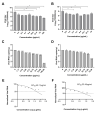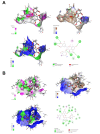Antiviral activity of myricetin glycosylated compounds isolated from Marcetia taxifolia against chikungunya virus
- PMID: 37662709
- PMCID: PMC10471840
- DOI: 10.17179/excli2023-6242
Antiviral activity of myricetin glycosylated compounds isolated from Marcetia taxifolia against chikungunya virus
Abstract
The chikungunya virus (CHIKV) has produced epidemic outbreaks of significant public health impact. The clinical symptoms of this disease are fever, polyarthralgia, and skin rash, generally self-limiting, although patients may develop a chronic disabling condition or suffer lethal complications. Unfortunately, there is no specific treatment or vaccine available. Thus, the search for effective therapies to control CHIKV infection is an urgent need. This study evaluated the antiviral activity of flavonoids isolated from Marcetia taxifolia by in vitro and in silico analysis. Cytotoxicity of compounds was determined by MTT assay and viral load was assessed in cell substrates supernatants by plaque-forming and RT-qPCR assays. Selected molecules were analyzed by molecular docking assays. Myricetin 3-rhamnoside (MR) and myricetin 3-(6-rhamnosylgalactoside) (MRG) were tested for antiviral assays and analyzed by the TCID50 method and RT-qPCR. MR exhibited dose-dependent antiviral activity, reducing viral titer at concentrations of 150-18.8 μg/mL by at least 1-log. Similarly, MRG showed a significant decrease in viral titer at concentrations of 37.5, 9.4, and 2.3 μg/mL. RT-qPCR analysis also displayed a substantial reduction of CHIKV RNA for both flavonoids. Furthermore, molecular docking of the selected flavonoids proposed the nsP3 macrodomain as a possible target of action. Our study reveals that MR and MRG could be considered promising anti-CHIKV therapeutic agents. Molecular modeling studies showed MR and MRG ligands with a high affinity for the N-terminal region of the nsP3 macrodomain, postulating them as a potential target of action for the CHIKV control.
Keywords: Marcetia taxifolia; antiviral activity; chikungunya; cytotoxicity; molecular modeling; myricetin.
Copyright © 2023 Muñoz et al.
Conflict of interest statement
The authors declare no conflict of interest.
Figures






References
-
- 3DS, Dassault Systèmes. Biovia Discovery Studio. v21.1.0.20298. San Diego, CA: Daussault Systèmes; 2020.
-
- Abdullah N, Ahemad N, Aliazis K, Khairat JE, Lee TC, Abdul Ahmad SA, et al. The putative roles and functions of indel, repetition and duplication events in alphavirus non-structural protein 3 hypervariable domain (nsP3 HVD) in evolution, viability and re-emergence. Viruses. 2021;13(6):1021. doi: 10.3390/v13061021. - DOI - PMC - PubMed
-
- Abraham MJ, Murtola T, Schulz R, Páll S, Smith JC, Hess B, et al. GROMACS: High performance molecular simulations through multi-level parallelism from laptops to supercomputers. SoftwareX. 2015;1-2:19–25. doi: 10.1016/j.softx.2015.06.001. - DOI
-
- Alvarez M, Rodriguez-Roche R, Bernardo L, Morier L, Guzman M. Improved dengue virus plaque formation on BHK21 and LLCMK2 cells: Evaluation of some factors. Dengue Bull. 2005;29(5):49–57.
LinkOut - more resources
Full Text Sources
